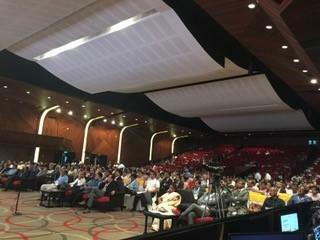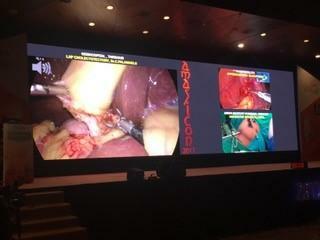
GEM Hospital & Research Center Streams Live with Streambox 4K
GEM Hospital and Research Center provides surgical training via GEM Televersity, a program of the GEM Institute of Laparoscopy and Robotic Surgery which provides daily live surgical experience, and monthly CME deploying real-time video streaming. Prof. R. Venkatachalam of the Institute wanted to extend this live surgical training experience to participants of a conference workshop about 160km (100mi) away.


Streambox's 4K OSX encoding software was used to capture and encode live video from Olympus 4K laparoscopic cameras and transported live video stream over a point-to-point IP network at a bitrate of 40Mbps to the conference facility where the video was played out on a large LED display. The video end-to-end latency was very short at about 0.8 to 1.2 seconds which was ideal for real-time training of surgical procedures over IP based networks to remote locations.
Prof. R. Venkatachalam commented, "The conference was great with live surgeries from 100 miles away. It so happened we launched 4K streaming on The World Audiovisual Day."
Streambox 4K Encoder is powered by Streambox ACT-L3 Codec that produces exceptional color depth and accuracy used in Broadcast and in Film Post Production industries. ACT-L3's more efficient encoding and wider color support provide a high-quality live video for large displays making it ideal for medical training.
For low latency reliable video transport over IP networks, Streambox has integrated into the Streambox 4K Encoder reliable LDMP (Low Delay Multi-Path) network transport protocol.
Streambox video transport products are particularly well suited for use in live video medical training; either onsite or at any remote location. There are three main opportunities when using live video for medical training:
- Students can view an unobstructed closeup of the procedure,
- Students can view team interactions and cooperation, and
- Students can be guided through the procedure by audio comments from the team (including, if appropriate, comments and questions from the students back to the team).
Streambox offers many exciting approaches to deliver these opportunities. Our equipment is deployed in many medical institutions around the world.
Deployment:
- Onsite Viewing Classrooms, conference rooms, study halls, libraries, and lecture halls are all great teaching locations to stream live procedures. In years gone by and on TV, they had operating theatres where students could only imagine what was happening. In the 21st century, the student can see exactly what the surgeon sees.
- Remote Viewing Since Streambox uses video transport over IP networks, live video can be streamed to any classroom in the world (as long as they have good internet connectivity). This can be accomplished via point-to-point or over the Streambox Cloud. Furthermore, the classroom could be on a student's laptop with Streambox Media Player installed. Or the classroom could be on each student's smartphone with Streambox's Android and iOS Media Player installed, and each student could be in a different country.
- Remote Consultation Using remote viewing, consults and critiques can take place from anywhere in the world. You don't need the expert in your OR to get quality feedback.
- Encryption Streambox encoders and decoders support AES 128-bit end-to-end video encryption ensuring that adherence to regulations on Protected Health Information (PHI) can be met. An AES 256-bit encryption option is available with a separate license and US Federal restrictions.
- Real-Time Video Streambox transport codecs are so efficient that latency within a local network can be 500msec and over the internet around 2 seconds (depending on the settings, internet bandwidth, and location of the viewer). This low latency along with its high video fidelity are why Streambox products are used by major news networks and movie studios.
- Remote Medicine Streambox remote encoders with cellular modem modules can provide live video streaming from field locations; e.g., streaming an ultrasound output to a regional medical center.
Equipment:
- HD and 4K Rackmount Encoders and Decoders HD images are great for viewing procedures on monitors up to about 90 inches. 4K is great for anything above 90-inch monitors.
- HD 2-Channel Synchronized Encoders 2-Channel synchronized encoders (also known as 3D encoders) allow for synchronized views from 2 cameras. This is ideal for watching synchronized closeup and wide-angle views; e.g., a synchronized closeup of a surgical procedure and a wider angle of the surgical team.
- HD Mobile Micro Encoders Mobile encoders are an economical way to have 1 or many cameras in the same or different locations. For example, one camera can be zoomed in for a closeup of the procedure while another 1 or 2 cameras can be simultaneously viewing the team's interaction. Or you could have streams from every procedure/operating room.
- Mobile Cellular Modules This allows the Micro encoder to be used from any location with cell/mobile connectivity. The opportunities are only limited by one's imagination; remote ultrasound, emergency first-aid stations or field hospitals, medical rescues and situational awareness, patient visualization at the scene or within a mobile ambulance or helicopter.
